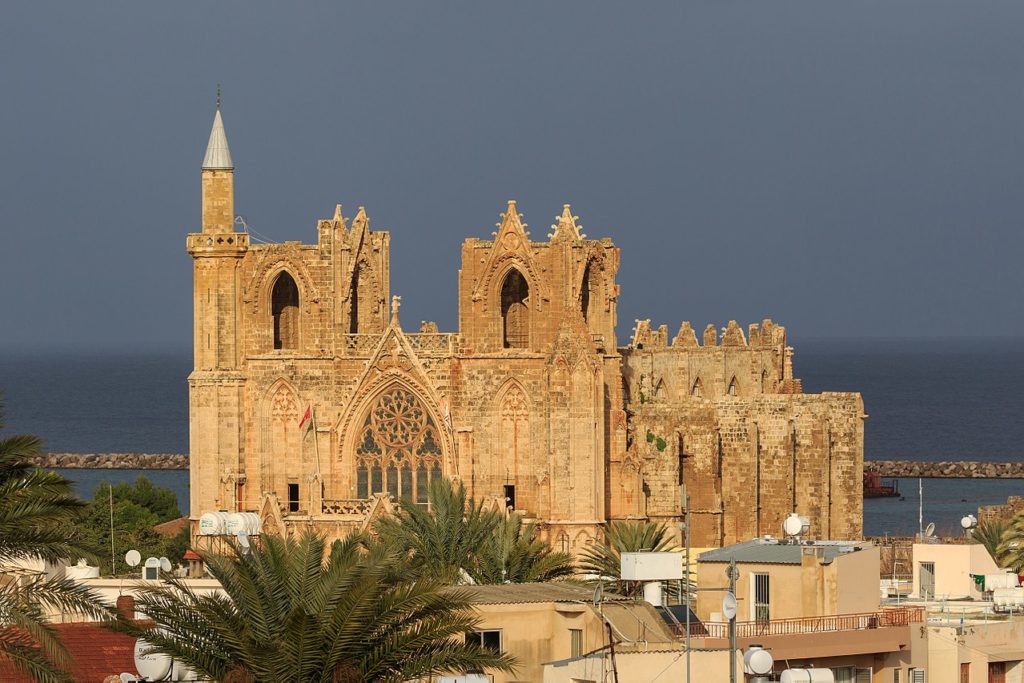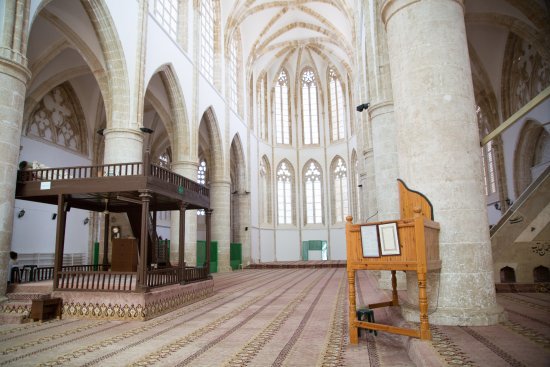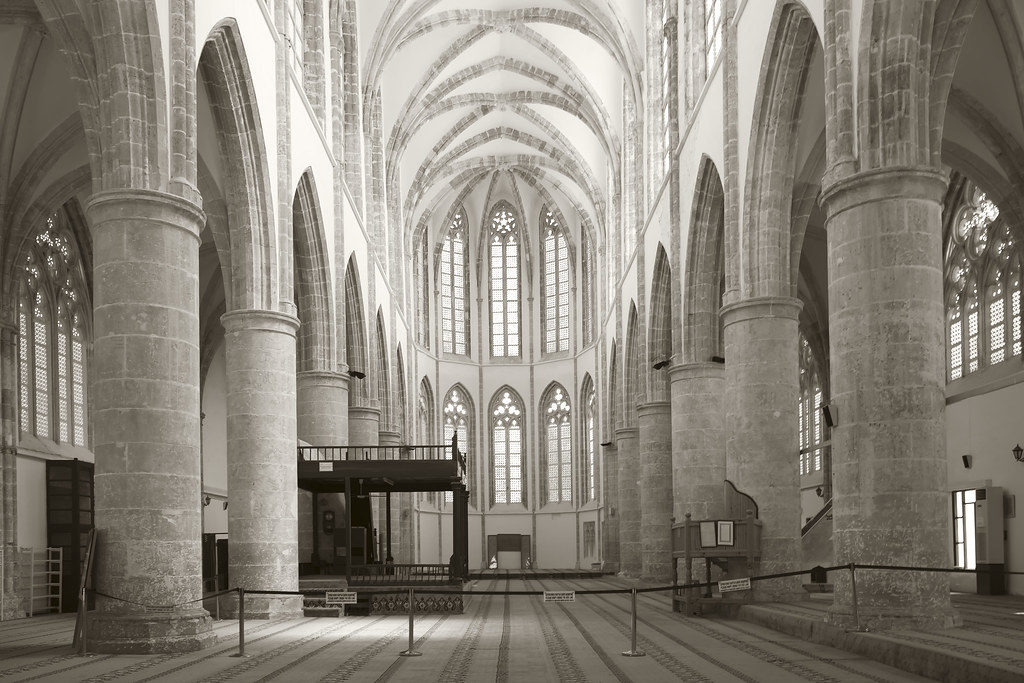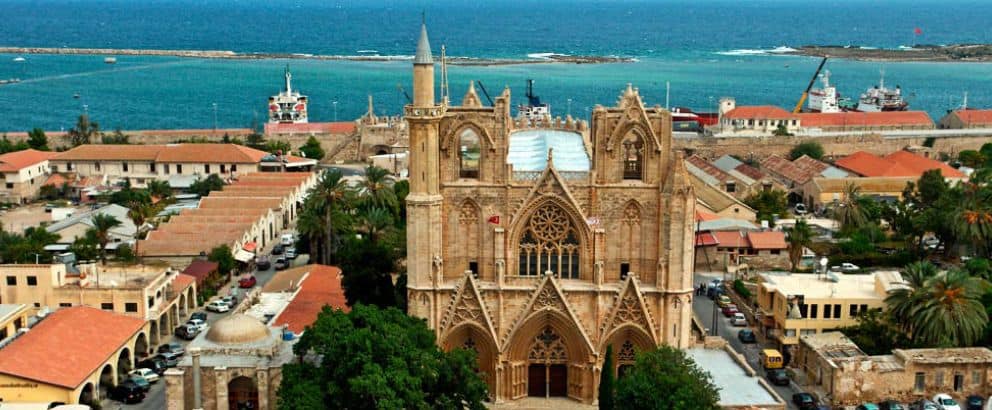
By Uzay Bulut
A devastating fire ravaged France’s Notre Dame Cathedral earlier this month, prompting worldwide heartbreak, commitments of rebuilding funds, and a vow to restore the structure from the French president. Meanwhile, the Notre Dame of Cyprus, St. Nicholas Cathedral, is used as a mosque in the northern part of the country, which has been illegally occupied by Turkey for nearly 50 years.
St. Nicholas, the most majestic structure in Famagusta, was constructed between 1298 and 1312 in the Gothic style. Kings of the House of Lusignan went to this church to be ceremonially crowned Kings of Jerusalem after they had been crowned as Kings of Cyprus in the St. Sophia Cathedral (now Selimiye Mosque) in Nicosia.
However, the Cathedral was transformed into a mosque with the addition of a mihrab and a minaret and renamed the “Lala Mustafa Pasha Mosque” in 1954, after the commander of the 1570 Ottoman attack against Cyprus.
“In 1570 the Ottoman invasion which took Nicosia, then Famagusta, in hideous and bloody sieges, marked the end of the natural life of the edifice as a place of Christian worship,” according to Michael Walsh, a professor of art and archaeology.

“Inside it was denuded of all decoration and Christian referencing in keeping with Islamic attitudes on graven images and heathen idols in the house of God. Sculptures were removed, destroyed or disfigured. Relics, such as the Water Pitcher from the Marriage of Cana in Galilee, disappeared into history, and the Royal tombs of James II (1473) and James III (1474) were both destroyed.”
The Ottoman occupation of Cyprus lasted until 1878. Britain then assumed administration of the island, and annexed it in 1914, after the Ottomans entered the First World War on Germany’s side. Cyprus became an independent Republic in 1960, and then a member of the United Nations and the European Union.

In 1952, Turkey joined the North Atlantic Treaty Organization (NATO). 22 years later, in 1974, Turkish forces invaded Cyprus once again and captured the northern part of the island, which they illegally occupy to this day.
During the campaign of invasion and ethnic cleansing, around 4,000 Greek Cypriots were allegedly murdered. The Cypriot government maintains that thousands of Greek-Cypriot civilians were arbitrarily arrested by the Turks, and many remain missing. The European Commission on Human Rights reported on the rape of several Greek Cypriot children and women, from ages 12 to 71, by Turkish troops. The nearly 200,000 Greek Cypriots who until then lived in the northern part of the country were terrorized by Turkish armed forces into fleeing their homes.
The lands, houses, businesses and other properties of the expelled or murdered Greek Cypriots were looted and seized by Turkish forces. The Turkish government then transferred settlers from Turkey to the occupied area, which had been majority-Greek Cypriot until 1974. Turkish settlers were then given homes and property belonging to Greek Cypriots as well as “citizenship” and “voting rights” in an attempt to forcibly change the demographic character of the island and Turkify it permanently.
A proof of this reality is that the names of every town, village or street has been changed to Turkish. For instance, Turks now call the Cypriot town of Trikomo “Iskele.” And the official website of the Turkish-occupied “Iskele Municipality” proudly lists the violated cathedrals, museums, harbors, castles, palaces, monasteries and other monuments in occupied Nicosia, Kyrenia, Famagusta and Morphou as “historical places” that should be visited by tourists.
The devastation of the cultural heritage of the occupied territories in Cyprus is ongoing. According to the Cypriot Embassy in Washington, D.C., there is documentation on 68 churches in the occupied area that have been converted into mosques, along with 14 appropriated by the Turkish military and a dozen into stables or barns. Many more have been simply looted or destroyed.

It is not just Christian holy sites that have been destroyed, either. According to a 2012 report by Cypriot historic preservationists, “The historic Margo Jewish Cemetery, a national monument for the Jewish people, southeast of Nicosia, has been desecrated and destroyed in the same way as Christian cemeteries in the area occupied by Turkish troops have been desecrated and destroyed.”
“Through its illegal occupation of Cyprus since 1974, Turkey has continued with Ottoman-era practices which restrict and subjugate the practice of Christianity,” Claire Evans, of the International Christian Concern (ICC), told The Daily Caller. “Believers regularly report surveillance and harassment from Turkish authorities. The authorities, however, do not stop there.”
“Restrictions are placed on access to historic Christian places of worship and items commonly used in worship, effectively preventing Christians from publicly practicing their faith,” she continued. “We must not make the mistake of thinking of Turkey’s religious freedom violations in Cyprus as an isolated incident. Turkey has a long history of using this tactic to demoralize and pressure Christians, keeping them as second-class citizens,” a tactic that includes converting historic churches into mosques.
One of those who fled their homes to escape the Turkish military invasion of Cyprus in 1974 is Tasoula Hadjitofi from Famagusta. She was 14 during the invasion. Hadjitofi and her family eventually settled in the Netherlands as refugees. There, she founded the “Walk of Truth,” a non-governmental organization tackling art trafficking and recovering the stolen religious heritage of Cyprus.
Hadjitofi has dedicated her life to bringing looted artifacts home to her native Cyprus in an effort to compensate for her own inability to return home, Famagusta.
“Asking for permission from occupying Turkey to pray in one’s Church is humiliating enough for the Christians of Cyprus,” Hadjitofi told The Daily Caller. “However, watching our Churches being converted into mosques is the optimum humiliation and rejection by Turkey of who we are and what our faith is. The Islamisation of the occupied area of Cyprus by Turkey and its cultural cleansing needs the immediate attention of the international community."
Indeed, Turkey is eradicating the 9,000-year-old cultural heritage of occupied northern Cyprus – including that of Hellenic, Roman, Byzantine, Venetian, Armenian, and Jewish civilizations – with the ultimate goal of annexing the area to Turkey. Meanwhile, the UN and EU have mostly been silent. Greek Cypriots have been abandoned in their efforts of ending the occupation of their country by Turkey, the second largest army in NATO.
“I have written about it before and I repeat: The occupied area of Cyprus is the first modern Islamist fundamentalist conquest of the West,” Philip Christopher, president of the International Coordinating Committee “Justice for Cyprus” (PSEKA), told the Daily Caller.
“And I think there will be more conquests in the future. It is so difficult to reverse the Turkish occupation of Cyprus. There are more than 500,000 illegal settlers and 43,000 occupation troops there. The Turkish-Cypriots are also victims. Their culture – the Cypriot culture – is becoming extinct.”
“As Turkey expands its presence in other countries, Cyprus serves as a warning of the threats which those Christians face,” added Evans. “Turkey is slowly and deliberately taking steps to ensure that Christianity does not flourish in the region, starting with the historic and sacred places of Christianity.”
Cyprus’ Notre Dame, and other treasures of Cypriot cultural heritage in the occupied area, although deformed, are still standing, patiently awaiting their liberation.
 *ABOUT Uzay Bulut: is a Turkish journalist and political analyst formerly based in Ankara. She graduated from Istanbul’s Bogazici University in 2007 with a BA in Translation and Interpreting Studies. She holds a master’s degree in Media and Cultural Studies at Ankara’s Middle East Technical University. Her writings have appeared in a variety of publications including Gatestone Institute, the Clarion Project, the Armenian Weekly, PJ Media, CBN News, the Algemeiner, the Kurdish newspaper Rudaw, International Business Times UK and the Voice of America. She has also contributed to several Israeli media outlets including the Jerusalem Post, Arutz Sheva (Israel National News), Israel Hayom and Jerusalem Online. Bulut’s journalistic work focuses mainly on Turkey’s ethnic and religious minorities, anti-Semitism, political Islam and the history of Turkey. She is currently based in Washington, D.C.
*ABOUT Uzay Bulut: is a Turkish journalist and political analyst formerly based in Ankara. She graduated from Istanbul’s Bogazici University in 2007 with a BA in Translation and Interpreting Studies. She holds a master’s degree in Media and Cultural Studies at Ankara’s Middle East Technical University. Her writings have appeared in a variety of publications including Gatestone Institute, the Clarion Project, the Armenian Weekly, PJ Media, CBN News, the Algemeiner, the Kurdish newspaper Rudaw, International Business Times UK and the Voice of America. She has also contributed to several Israeli media outlets including the Jerusalem Post, Arutz Sheva (Israel National News), Israel Hayom and Jerusalem Online. Bulut’s journalistic work focuses mainly on Turkey’s ethnic and religious minorities, anti-Semitism, political Islam and the history of Turkey. She is currently based in Washington, D.C.

Although the cultural damage caused by the 1974 invasion was immense, St Nicholas Cathedral in Famagusta is not a good example to illustrate it. It was turned into a mosque in 1571, not after 1974, and has been a mosque for almost 450 years.